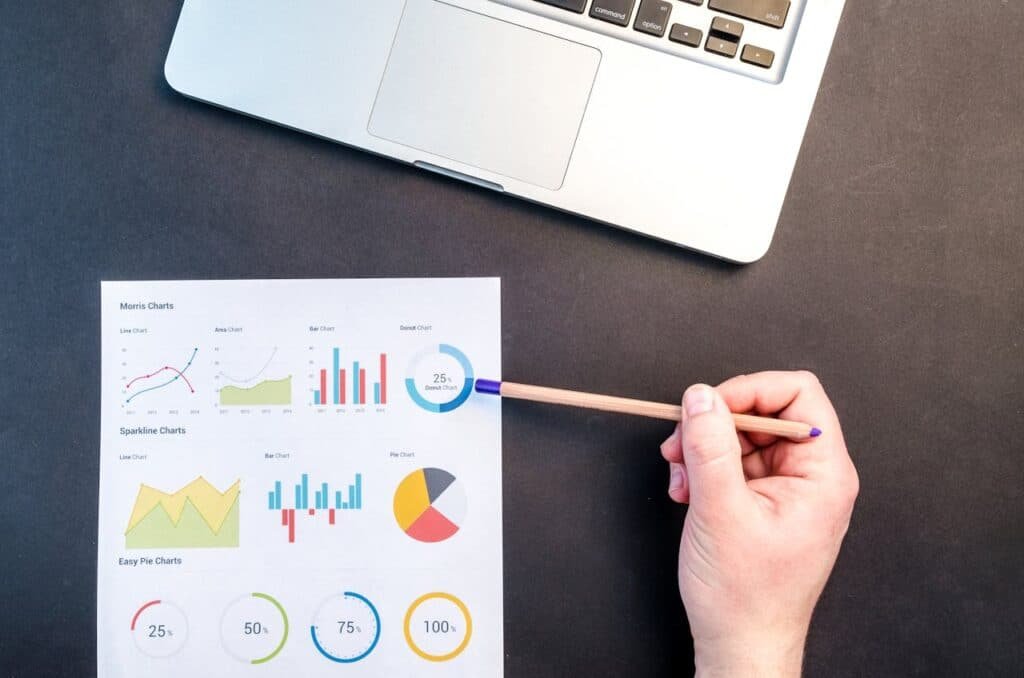Data, as we all know by now, is the backbone of innovation and success in various domains. It assists in understanding hidden secrets, uncovering them, and utilizing them in clever decision-making. Sounds amazing, doesn’t it? Then you can consider the career of a data analyst. What is their role? Raw data is helpful only when it’s transformed into actionable acumen, strategies, and predictive trends. This is what data analysts do, convert scattered data into clear insights that power business decisions.
According to the U.S. Bureau of Labor Statistics (BLS), data analyst demand is expected to surge at a 22% rate till 2030, and each year will see a job opening of over 30,000 new roles in this domain.
In this data analyst roadmap, I will be sharing some guidelines, tools, and skills required to become a successful data analyst.
What is Data Analysis?
It is the process of converting scattered and messy data by inspecting, cleaning, and modeling it into actionable insights. As a data analyst, you must be proficient in statistical analysis, data manipulation using tools like Python and R, and creating data visualizations.
Data analysis requires you to use these abilities to understand patterns, correlations, and trends within datasets. Resultantly, you can make insightful decisions that help to innovate, predict trends, and strategies across various sectors. Data analysts use techniques like data mining and machine learning to convert massive amounts of data into actionable insights that drive growth and operational efficiency.

Step-By-Step Data Analyst Roadmap
Becoming a data analyst in 2026 requires practice and passion, more than having any formal degrees. Having a clear portfolio will showcase your skills to the right people and can drive career growth. Though a background in mathematics, statistics, computer science, and IT is a plus. You can get a myriad of paid/ free online guides, tutorials, and courses to learn or enhance your data science skills.
1. Study How Businesses Utilize Data:
- To get a better understanding, study real-world use cases like how data drives e-commerce marketing campaigns, how it is used in healthcare optimization, and in banking/ finance fraud detection.
- Check skill requirements for the top data analyst role, like SQL, Excel, Python, and data visualization tools.
2. Ask the Right Questions:
- Learn to turn varied business/ organizational problems into structured, data-related questions. This skill will highlight you during interviews and a job.
3. Start Hands-On Projects:
- Kaggle and public repositories offer real business data sets. You can download them easily.
- Use real business situations and mimic them to practice case studies, like customer churn analysis or sales forecasting.
4. Get Formal or Certification Courses:
- A bachelor’s degree in fields like mathematics, IT, computer science, etc., can prove to be helpful, but is not mandatorily required.
- You can opt for certification courses in Excel, SQL, Python/R, Tableau, Power BI, or analytics bootcamps.
5. Keep Your Portfolio Ready:
- Use mediums like GitHub repositories, your own website, Notion page, etc., to display your analytics skills, like projects, dashboards, and insight summaries.
Related: Top Data Science Projects for Your Portfolio From Beginner To Advanced
Data Analyst’s Learning Plan (Month-Wise)
Month 0
Gain a thorough understanding of how data is used in practical business scenarios and develop your analytical mind.
Month 1
Learn Excel through and through, and understand basic descriptive statistics.
Month 2
For data extraction and manipulation, fluently utilize SQL.
Month 3
Learn how to create dashboards on Tableau or Power BI. Also, practice storytelling with data.
Month 4
Gain an end-to-end knowledge of Python for analysis, specifically with Pandas, NumPy, Matplotlib, and Seaborn.
Month 5
Gather case studies and start building your portfolio.
Month 6
Start preparing for interviews, build your resume, optimize your LinkedIn profile, and work on mock interview questions.
Important Skills for a Data Analyst

Technical Skills
- Excel: Primary to advanced functions, pivot tables, VLOOKUP, Index Match, and dynamic chart creation.
- SQL: Data querying, joins, aggregations, subqueries, and data set analysis are vital for most data analyst roles.
- Python or R: Data cleaning, analysis, and visualization via libraries like Pandas, NumPy, Matplotlib, and Seaborn.
- Statistics: Descriptive statistics, distributions, sampling, A/B testing, and data-powered decision-making.
- Data Visualization: Creating dashboards and visuals in Tableau, Power BI, or Python visualization libraries.
- Cloud and Big Data: Knowledge on Spark, Google Cloud, AWS, or Azure is highly appreciated.
Analytical and Domain Skills
- Critical thinking, problem definition, and transforming business questions into data hypotheses.
- Gain knowledge on the organization’s business model based on finance, retail, healthcare, or e-commerce.
Communication:
- You must know how to simplify complicated insights for non-tech stakeholders. You need to know about visual storytelling and actionable recommendations.
Growing Experience and Networking:
- Gain experience by working on open datasets or quick projects.
- Use Kaggle and DrivenData to participate in competitions and hackathons.
- Use LinkedIn to interact with like-minded people, use data communities like datascience/ R, or tech meetups to mingle with tech professionals.
Related: How To Become a Marketing Analyst
Data Analyst Career Path
- Junior Data Analyst
- Data Analyst
- Senior Analyst
- Business Intelligence Analyst
- Data Scientist/Manager
- Chief Data Officer or Analytics Leader
Data Analyst Roles and Responsibilities
They are an important part of modern businesses because they gather and retrieve valuable information for growth. Their responsibilities overall include ensuring the reliability of data, clarifying insights, and providing useful data for decision-making. Below are some of their key responsibilities.

Data Cleaning & Preparation
Raw data might contain gaps, inconsistencies, mistakes, etc. Data analysts identify these, clean them, and provide data that is reliable. They develop and maintain data storage systems for easy access and security.
Data Analysis & Interpretation
After the first step is over, analysts use the clean data to understand patterns, trends, and insights. They convert this analysis into understandable insights that make business decisions easier and market-worthy.
Data Visualization & Reporting
To make the data meaningful, analysts design charts, dashboards, and reports. These visualizations ensure that non-tech business leaders, team members can easily understand it.
Data-Backed Business Decisions
Reports and insights generated by analysts are hugely vital for modern businesses. This ensures that decisions are data-backed, planned, and provide solutions across various sectors like finance, banking, marketing, etc.
Tech & Tools
As already discussed, analysts rely heavily on Excel, SQL, Python, Tableau, and Power BI to analyze and manage data. They must keep up with new technological innovations that make their job simpler and more accurate.
Collaboration With Teams
Analysts works with marketers, engineers, tech managers, and product managers, listen to business needs, and provide insightful data that aids in the business’s needs and overall growth.
Types of Data Analysts in 2026
- Business Analysts: Their main focus is to improve organizational processes and strategies.
- Financial Analysts: They utilize financial data and interpret it to predict trends, guide budgeting, and make investment decisions.
- Marketing Analysts: They analyze customer behaviour, performance of campaigns, and market trends. They use data to increase engagement, improve ROI, and drive growth.
- Operations Analysts: They study data related to workflows, supply chains, and logistics.
- Healthcare Data Analysts: They understand medical data, like patient records, clinical trials, etc., to improve research, provide optimum patient care, and guide policies.
- Product Analysts: They study user data to improve products and enhance sales outcomes.
- Risk Analysts: They use data to recognize and mitigate any incoming risks, especially in financial markets, operational processes, or cybersecurity situations.
- Data Scientists: They use machine learning and predictive analysis advanced techniques to handle complex datasets.
- Cybersecurity Analysts: They analyze and study data to identify, mitigate, and prevent potential cybersecurity threats.
- HR Data Analysts: They utilize workforce data for improving recruitment and strategizing for employee engagement and retention.
- Sports Data Analysts: They use data to understand player performance, statistics of games, and team planning.
- Geospatial Data Analysts: They study location-based data to recognize trends and spatial patterns. Their work is used in city planning, conserving the environment, and optimizing logistics.
Also Read: Top Programming Languages For Artificial Intelligence (AI) Apps
Important Tools for Data Analysts
| Tool | Use Case | Why Important for 2026? |
| Excel | Data cleaning, summaries, and visualization | Vital for SMEs, interviews |
| SQL | Database querying and reporting | A must for data jobs |
| Python | Data manipulation, analysis, and visualization | Most popular for advanced analytics |
| R | Advanced stats, research analysis | Used mostly in academia, finance |
| Tableau | Interactive dashboards, visualization | In-demand, cloud support |
| Power BI | BI tracking, business dashboards | Integration with Microsoft tools |
| Google Analytics | Website & product analytics | Digital marketing, e-commerce |
| Alteryx/KNIME | Data automation, ETL, ML pipelines | Used in large enterprise analytics |
| Spark | Big data analysis, scalable compute | For large dataset processing |
| Qlik | Associative, real-time BI | Alternative to Tableau/Power BI |
Data Analyst Salary Expectations in 2026
Data analyst salaries differ by country, industry, experience, and skill level.
United States:
Entry-level starts at $53,500 to $63,250
Seniors average $92,750 to $115,000 in finance.
India:
Entry-level ₹4 to 6 LPA (lakhs per annum)
Mid-level approx. ₹8 to 12 LPA
Seniors over ₹20 LPA, especially with Python, SQL, Tableau/Power BI skills.
Europe (UK, Germany):
UK averages £28,317 to £32,413
Germany approx. €46,922.
Why Salaries Vary?
- Years of experience and projects.
- Proficiency in must-have skills (Python/SQL/Visualization).
- Industry (tech, finance, e-commerce pays more).
- Region/ country and size of company.
Conclusion: Your Pathway in 2026
Just like any other profession today, the role and responsibilities of data analysts are ever-evolving. In the upcoming years, analysts who understand machine learning, have experience in big data, cloud-based analytics, and a deep understanding of data privacy regulations will be highly valuable.
In the blog, I have provided you with an extensive guide to becoming a successful data analyst in 2026. From understanding its definition, introducing the skills and tools, giving salary insights, data analyst types, etc., you have a complete data analysis roadmap for 2026. If you are already excited, there are numerous online courses available. Just enroll in one as soon as possible and start your career in data analytics today.
Related: Top Cybersecurity Careers in 2026







